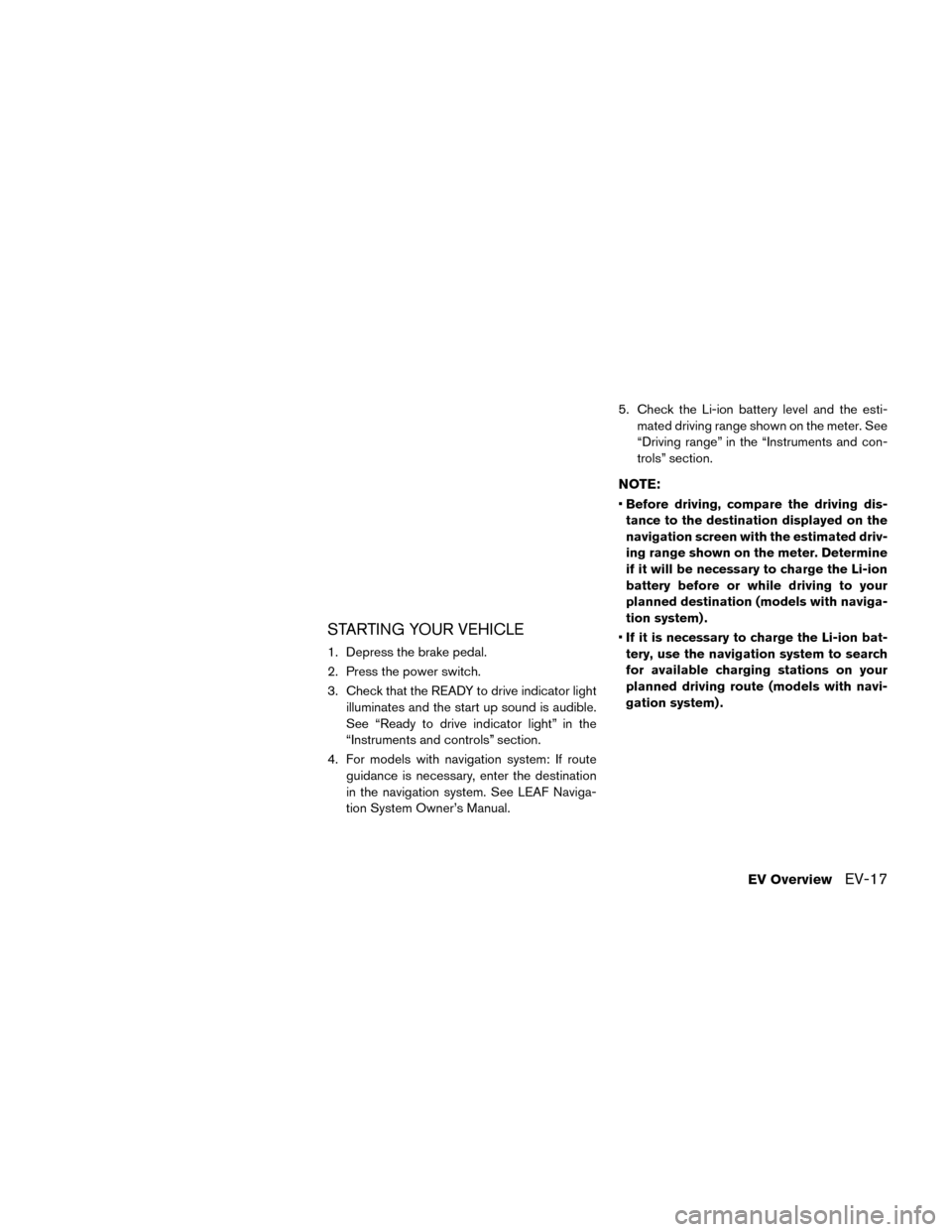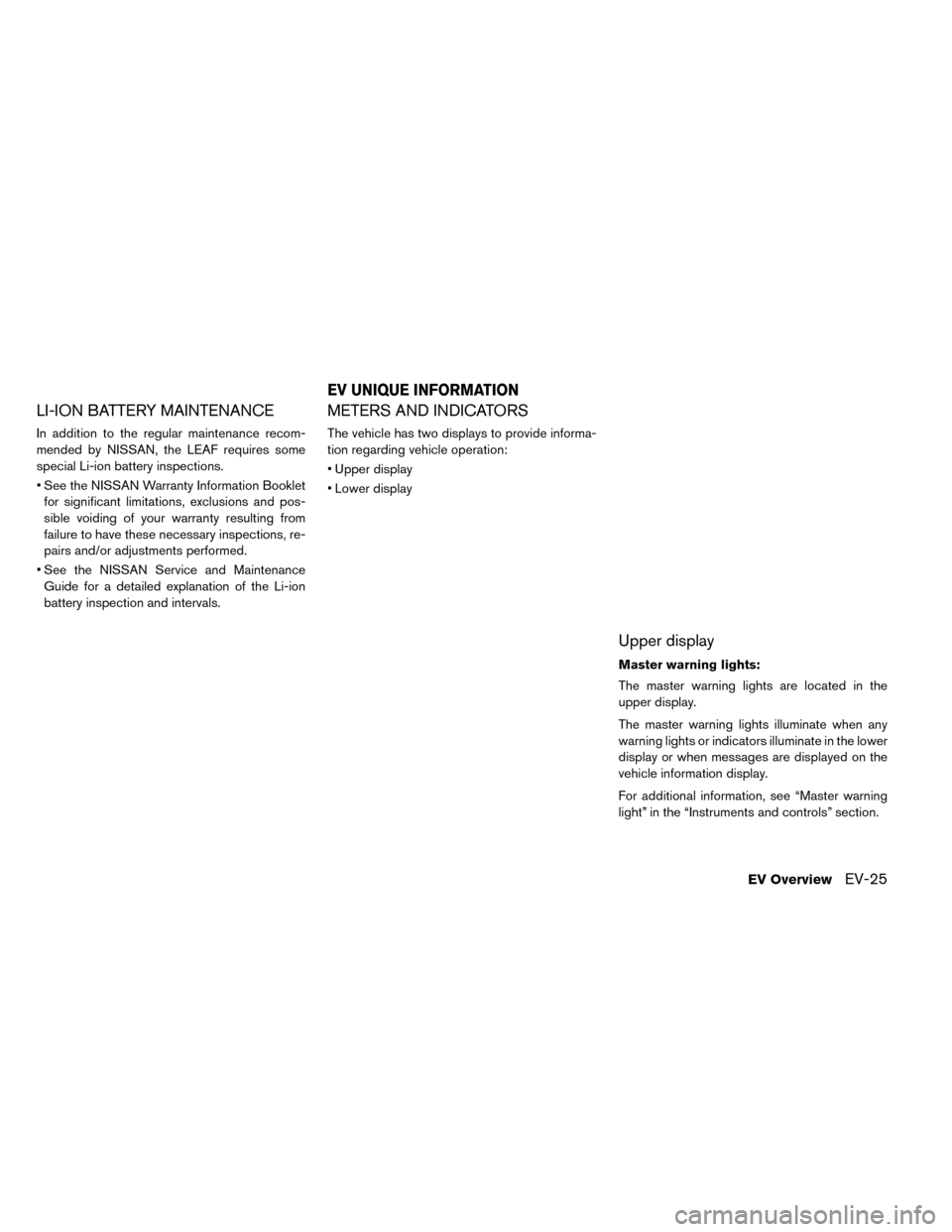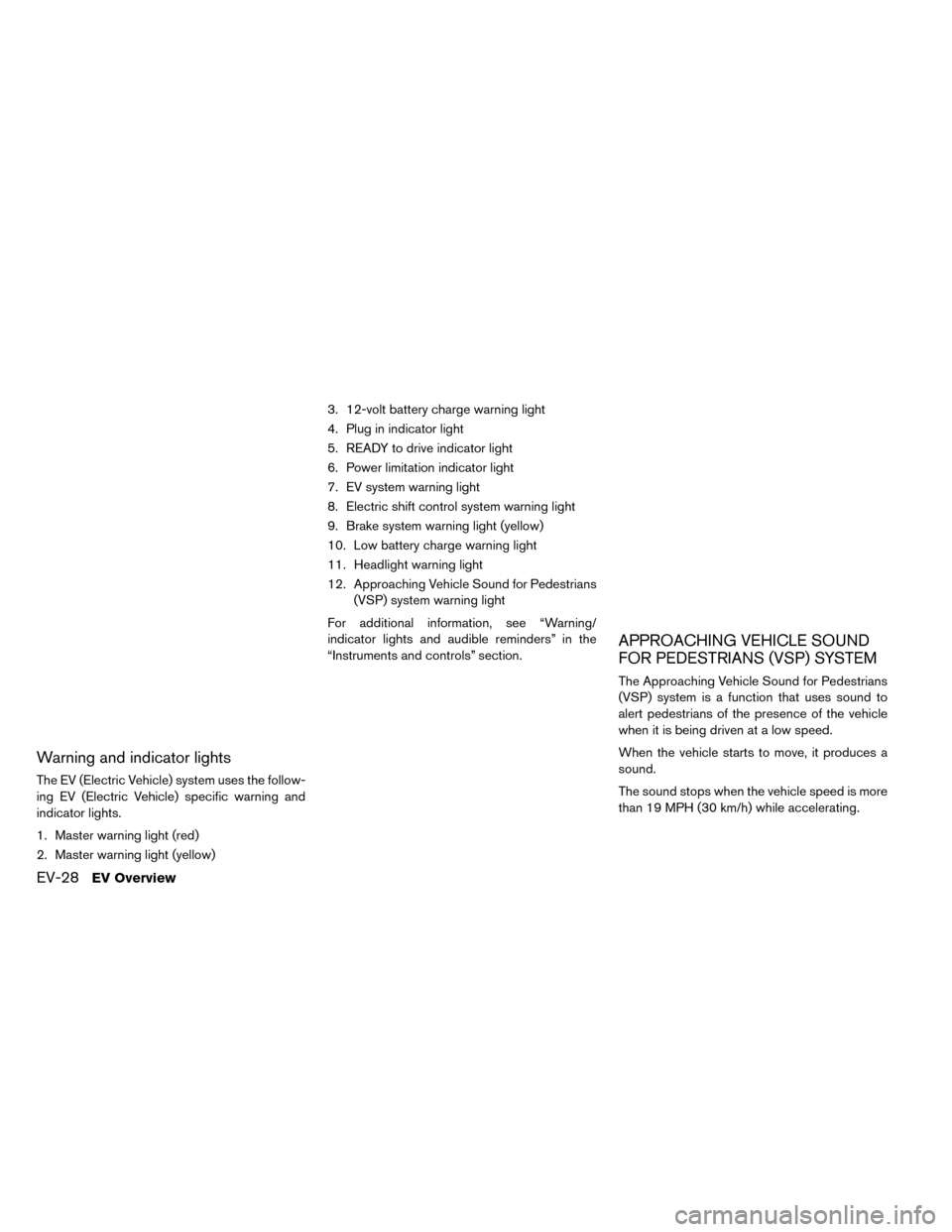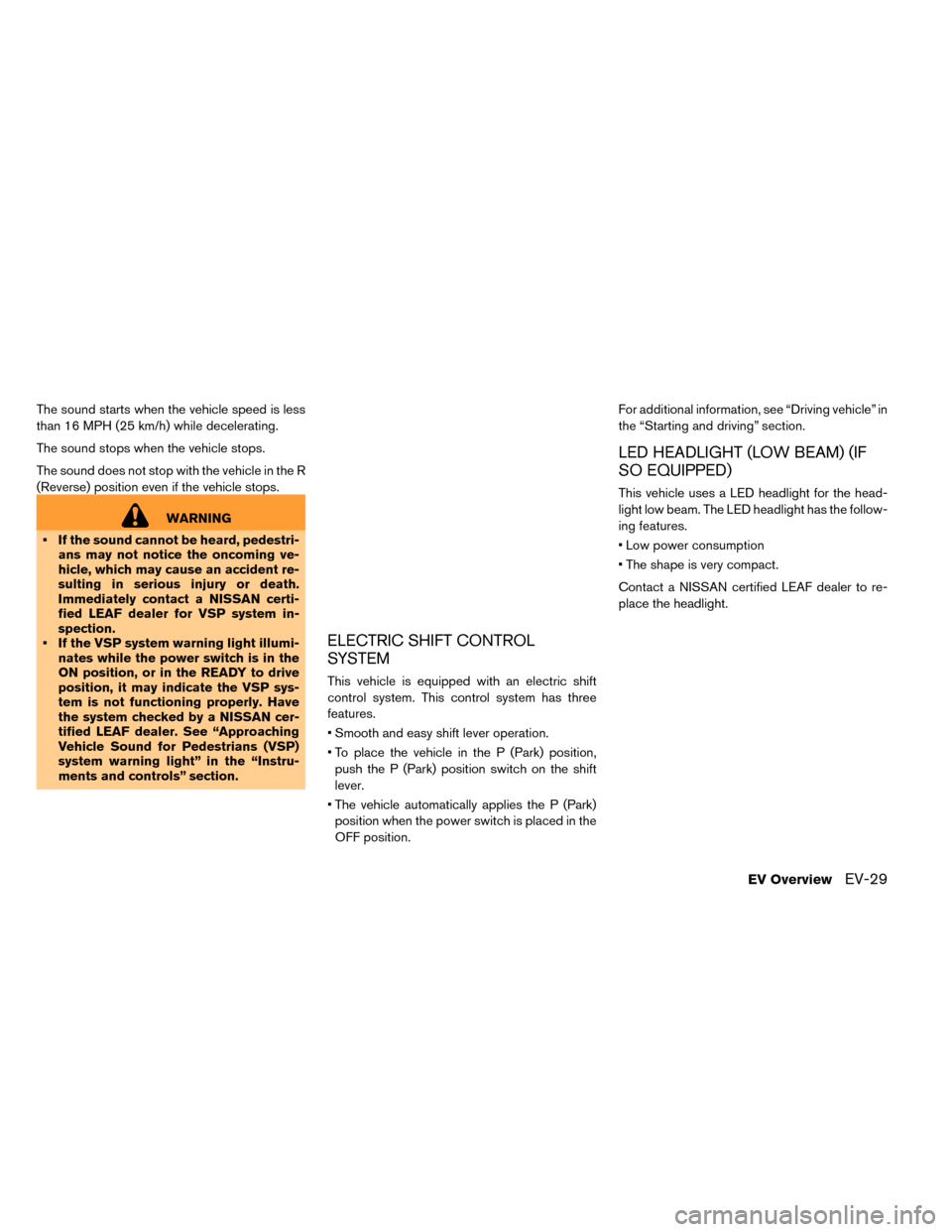Page 38 of 412

STARTING YOUR VEHICLE
1. Depress the brake pedal.
2. Press the power switch.
3. Check that the READY to drive indicator lightilluminates and the start up sound is audible.
See “Ready to drive indicator light” in the
“Instruments and controls” section.
4. For models with navigation system: If route guidance is necessary, enter the destination
in the navigation system. See LEAF Naviga-
tion System Owner’s Manual. 5. Check the Li-ion battery level and the esti-
mated driving range shown on the meter. See
“Driving range” in the “Instruments and con-
trols” section.
NOTE:
•Before driving, compare the driving dis-
tance to the destination displayed on the
navigation screen with the estimated driv-
ing range shown on the meter. Determine
if it will be necessary to charge the Li-ion
battery before or while driving to your
planned destination (models with naviga-
tion system) .
• If it is necessary to charge the Li-ion bat-
tery, use the navigation system to search
for available charging stations on your
planned driving route (models with navi-
gation system) .
EV OverviewEV-17
Page 41 of 412
If the low battery charge warning light
illuminates, the Li-ion battery charge is too low for
travel. See�Low battery charge warning light” in
the “Instruments and controls” section. Charge
the Li-ion battery as soon as possible.
EV-20EV Overview
Page 45 of 412

• Release the accelerator pedal to slow downand do not apply the brakes when traffic and
road conditions allow. – This vehicle is equipped with a regenerative brake system. The primary purpose of re-
generative brake system is to provide some
power to recharge the Li-ion battery and
extend driving range. A secondary benefit is
“engine braking” that operates based on
Li-ion battery conditions. In the D (Drive)
position, when the accelerator is released,
the regenerative brake system provides
some deceleration and some power to the
Li-ion battery.
LI-ION BATTERY LIFE
The Li-ion battery’s ability to hold a charge, like all
batteries, decreases with battery age and usage
which results in decreased vehicle range when
compared to the vehicle range when the vehicle
was new. This is normal and expected, and does
not indicate a malfunction of the vehicle or Li-ion
battery. The Li-ion battery’s ability to hold a charge can be
affected by how you drive the vehicle, store the
vehicle, how you charge the Li-ion battery and
Li-ion battery temperature during vehicle opera-
tion and charging.
To maximize the battery’s useful life, use the fol-
lowing driving and charging habits where pos-
sible:
• Avoid exposing a vehicle to extreme ambient
temperatures for extended periods.
• Avoid storing a vehicle in temperatures below −13°F (−25°C) for over 7 days.
• Avoid leaving your vehicle for over 14 days where the Li-ion battery available charge gauge
reaches a zero or near zero (state of charge) .
• Allow the vehicle and Li-ion battery to cool down after use before charging.
• Park/store your vehicle in cool locations out of direct sunlight and away from heat sources.
• Avoid sustained high battery temperatures (caused, for example, by exposure to very high
ambient temperatures or extending highway
driving with multiple quick charges) . • Use the normal charging or trickle charging
methods to charge the Li-ion battery and mini-
mize the use of public Fast Charge or Quick
Charger.
• Avoid repetitive charging of the Li-ion battery with high battery state of charge.
• Moderate driving.
• Use of ECO mode.
• If the vehicle will not be used for an extended period of time, charge the Li-ion battery once
every 3 months. Do not operate the charging
timer repeatedly while the charge connector is
connected to the vehicle after the Li-ion battery
charging is completed. Doing so may discharge
the 12-volt battery.
The power of the Li-ion battery can be
checked on the Li-ion battery available charge
gauge. See “Li-ion battery available charge
gauge” in the “Instruments and controls” for
details.
EV-24EV Overview
Page 46 of 412

LI-ION BATTERY MAINTENANCE
In addition to the regular maintenance recom-
mended by NISSAN, the LEAF requires some
special Li-ion battery inspections.
• See the NISSAN Warranty Information Bookletfor significant limitations, exclusions and pos-
sible voiding of your warranty resulting from
failure to have these necessary inspections, re-
pairs and/or adjustments performed.
• See the NISSAN Service and Maintenance Guide for a detailed explanation of the Li-ion
battery inspection and intervals.
METERS AND INDICATORS
The vehicle has two displays to provide informa-
tion regarding vehicle operation:
• Upper display
• Lower display
Upper display
Master warning lights:
The master warning lights are located in the
upper display.
The master warning lights illuminate when any
warning lights or indicators illuminate in the lower
display or when messages are displayed on the
vehicle information display.
For additional information, see “Master warning
light” in the “Instruments and controls” section.
EV UNIQUE INFORMATION
EV OverviewEV-25
Page 49 of 412

Warning and indicator lights
The EV (Electric Vehicle) system uses the follow-
ing EV (Electric Vehicle) specific warning and
indicator lights.
1. Master warning light (red)
2. Master warning light (yellow)3. 12-volt battery charge warning light
4. Plug in indicator light
5. READY to drive indicator light
6. Power limitation indicator light
7. EV system warning light
8. Electric shift control system warning light
9. Brake system warning light (yellow)
10. Low battery charge warning light
11. Headlight warning light
12. Approaching Vehicle Sound for Pedestrians
(VSP) system warning light
For additional information, see “Warning/
indicator lights and audible reminders” in the
“Instruments and controls” section.
APPROACHING VEHICLE SOUND
FOR PEDESTRIANS (VSP) SYSTEM
The Approaching Vehicle Sound for Pedestrians
(VSP) system is a function that uses sound to
alert pedestrians of the presence of the vehicle
when it is being driven at a low speed.
When the vehicle starts to move, it produces a
sound.
The sound stops when the vehicle speed is more
than 19 MPH (30 km/h) while accelerating.
EV-28EV Overview
Page 50 of 412

The sound starts when the vehicle speed is less
than 16 MPH (25 km/h) while decelerating.
The sound stops when the vehicle stops.
The sound does not stop with the vehicle in the R
(Reverse) position even if the vehicle stops.
WARNING
• If the sound cannot be heard, pedestri- ans may not notice the oncoming ve-
hicle, which may cause an accident re-
sulting in serious injury or death.
Immediately contact a NISSAN certi-
fied LEAF dealer for VSP system in-
spection.
• If the VSP system warning light illumi- nates while the power switch is in the
ON position, or in the READY to drive
position, it may indicate the VSP sys-
tem is not functioning properly. Have
the system checked by a NISSAN cer-
tified LEAF dealer. See “Approaching
Vehicle Sound for Pedestrians (VSP)
system warning light” in the “Instru-
ments and controls” section.
ELECTRIC SHIFT CONTROL
SYSTEM
This vehicle is equipped with an electric shift
control system. This control system has three
features.
• Smooth and easy shift lever operation.
• To place the vehicle in the P (Park) position,
push the P (Park) position switch on the shift
lever.
• The vehicle automatically applies the P (Park) position when the power switch is placed in the
OFF position. For additional information, see “Driving vehicle” in
the “Starting and driving” section.
LED HEADLIGHT (LOW BEAM) (IF
SO EQUIPPED)
This vehicle uses a LED headlight for the head-
light low beam. The LED headlight has the follow-
ing features.
• Low power consumption
• The shape is very compact.
Contact a NISSAN certified LEAF dealer to re-
place the headlight.
EV OverviewEV-29
Page 51 of 412
SOLAR CELL MODULE (IF SO
EQUIPPED)
This vehicle uses a solar cell module to provide
power to the 12-volt battery. The solar cell mod-
ule only provides power to help maintain the
charge of the 12-volt battery; it will not recharge
a discharged 12-volt battery.
The solar cell module does not provide power to
the Li-ion battery.
For maintenance, see “Cleaning exterior” in the
“Appearance and care” section.
NOTE:
The solar cell may not provide full charging
power in the following situations.
•When the intensity of sunlight is weak.
• When the solar cell module is in the
shade.
• When the solar cell module is covered by
leaves or dirt.
DRIVING RANGE BUTTON (IF SO
EQUIPPED)
Push the driving range button on the steering
wheel to check the estimated distance the ve-
hicle may be driven with the available Li-ion bat-
tery charge. See LEAF Navigation System Own-
er’s Manual.
Solar cell module on the rear spoiler
EV-30EV Overview
Page 52 of 412
Charging
Precautions on charging................. .CH-2
Types of charge and how to charge the Li-ion
battery ........................... .CH-5
How to normal charge ................ .CH-9
How to trickle charge ................ .CH-11
How to quick charge (if so equipped) .......CH-15
Charge connector lock switch ...........CH-18
Charging methods ................... .CH-21
Charging timer ................... .CH-21
Immediate charge .................. .CH-26Charging related remote function (models with
navigation system)
................. .CH-27
Charging related indicator lights ............CH-28
Charging status indicator lights ...........CH-28
EVSE (Electric Vehicle Supply Equipment)
control box indicator light ..............CH-31
Charging troubleshooting guide ............CH-33